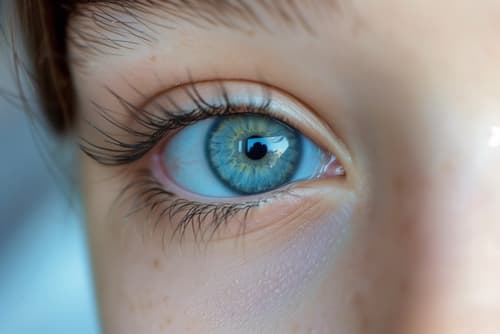
There are many ways to protect children’s eye health and safety. During Children’s Eye Health and Safety Month, remind yourself of how to prioritize vision, eye care, and screen time. If you have questions about your child’s eyes or suspect they may have an infection or problem, visit me, Dr. Maria Swetech, to find out what’s happening.
Pediatric Eye Exams and Vision Screenings
A basic pediatric eye exam is typically conducted during a well-child visit to gauge visual acuity, eye alignment, and overall eye health. There are several components to the exam, though it is usually quick and perfunctory. Vision screening is done to detect risk factors and identify abnormalities where children’s eye health is concerned.
- Kids age three and older read a chart appropriate for their age to identify pictures or letters.
- Eyes are tested separately.
- Depth perception, eye alignment, and motility are done to identify lazy eye or crossed eyes.
- The external areas of the eye like the lids and cornea, for example, are checked for abnormalities, infection, or other problems.
Children may be referred to an ophthalmologist for further investigation and a comprehensive evaluation of the eyes should there be any concerning or unclear results from this routine screening.
Signs of Vision Problems in Children
School is one of the most common places where kids exhibit vision problems. It may be difficult for them to read the board from a distance or read papers or books clearly. Teachers and parents may notice the child doing any of the following:
- Squinting, leaning forward, or tilting their head to see better.
- Sitting too close to the television or holding a book or screen too close to their eyes.
- Having trouble tracking objects or following a text.
- Complaining about dizziness, headaches, or blurry vision.
Screen Time Tips
Today’s children have yet another strain on their eyesight from an early age because of tablet and phone screens. The American Academy of Pediatrics recommends screen time limits that do not interfere with healthy behaviors including sleep or exercise.
Some of the safest things you can do to help protect your child’s eyesight while on screens is to:
- Set clear screen time limits and stick to them consistently.
- Use parental controls to limit usage and manage access.
- Encourage alternate activities that do not cause eye strain.
- Designate screen-free zones in your home.
- Demonstrate your own healthy screen habits.
Protect Eyes During Sports and Play
Just as kids need to protect their heads and teeth when they play contact sports, so too do their eyes need to be protected. Outdoor play requires its own set of careful parameters too:
- Wear goggles or other protective eye gear when playing sports.
- Wear safety glasses during contact sports if your child already has a prescription for glasses.
- Wear sunglasses and a brimmed hat outside and minimize high UV exposure.
Children’s Eye Health and Safety Month
Everyone only gets one pair of eyes and it’s essential to care for them. Make an appointment with me, Dr. Maria Swetech, to discuss eye health, concerns, or questions. Schedule an appointment today.
Nothing in this blog is official medical advice. See your doctor for customized care.